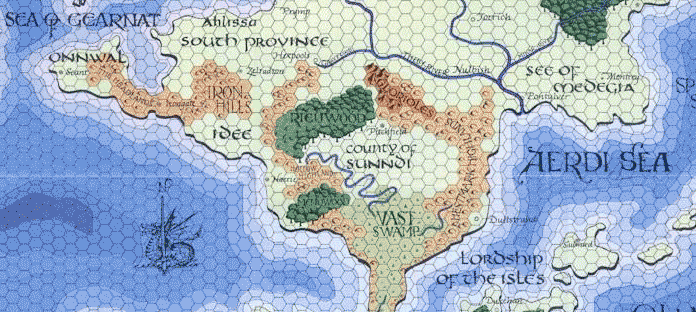I’ve decided to use the Triumph! miniatures rules (by the Washington Grand Company) for this particular project. I had the opportunity to try them out at Historicon a few years ago, and they fall right into my sweet spot. Simple enough for me to learn the basics in a few minutes, but with enough variety in the troop types and nuance in the tactics that it’s not too abstract.
Variety in Triumph! is achieved in two ways; the troop types and battle cards. The troop types are an obvious staple of just about every miniatures game; you have archers, and light foot, and knights, and so forth. Battle cards are a nice addition, though, and allow the game to provide specific benefits to specific armies and troop types. A number of battle cards are described here.
For instance, a feudal English army has a troop type called “bad horse”. In the feudal English army, the bad horse has a battle card called “Mid-Battle Dismounting” because they’re hoblars, who ride into battle but fight on foot. Meanwhile, a Marian Roman army also uses the “bad horse” troop type, but doesn’t have the battle card, so their bad horse doesn’t have that ability. In that way, the game avoids having scores of different troop types, and maximizes flexibility by having special rules for troops on the cards. And the cards can also be one-shots, so once the ability is used, it’s gone, and there can be scenario-specific cards as well.
Especially in a fantasy game that uses magic and non-human races, I might make great use of the cards. That way the army of the Iron Hills can still be made up of normal unit types, but with battle cards to give the flavor of their dwarven nature.
By the way, there are hundreds of historical army lists available for free on the Meshwesh website, maintained by the Washington Grand Company. They also list the battle cards and troop types.
One of the peculiarities of Triumph! is that there is no set scale for the figures. That is, it’s impossible to say that “one figure equals 200 soldiers”. The game is deliberately made this way to allow the armies to scale up or down to give greater or lesser granularity. You want to have all of your skirmishers in a single unit, and only a few units of infantry and cavalry to move around? Pick a small point value for the armies. You want to have dozens of units to move around on each turn, to increase your tactical control? Increase the point values of the armies. That’s called “Grand Triumph” and basically means you double or triple the number of points for each army, and therefore units on the board.
The key, though, is that the unit types remain proportional. So a Pre-Viking Army would normally have between 3 and 6 Elite Foot units (each costing 4 points). In a Grand Triumph game, you would have between 6 and 12, or 9 and 18, such units, and two or three times as many points to buy them with. You get finer granularity over your army composition, as long as they stay within those broad proportional guidelines. Here’s a video explaining the whole concept:
So with all that said, I think I’m at a point where I can start putting together the army lists for the war between the Great Kingdom and the Iron League. Tune in next time!









